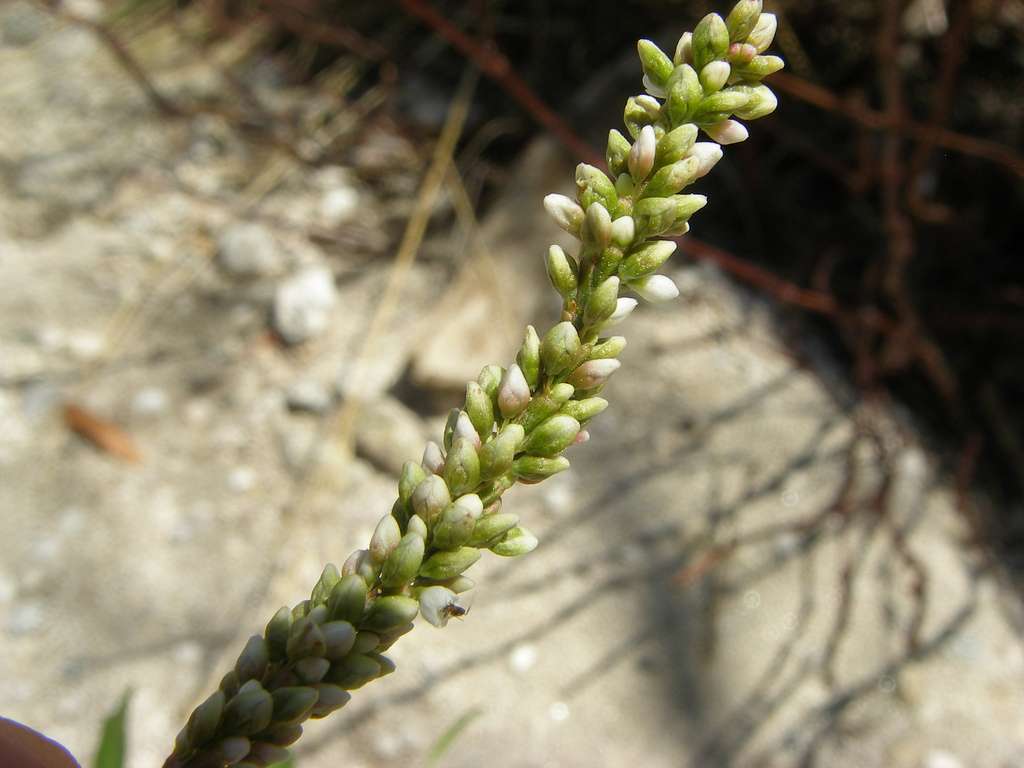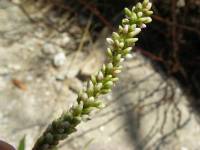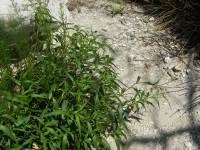Plants annual or perennial, 1.5-12 dm; roots also often arising from proximal nodes; rhizomes often present. Stems ascending to erect, branched, without noticeable ribs, glabrous, glandular-punctate. Leaves: ocrea brown, cylindric, (4-)9-18 mm, chartaceous, base inflated, margins truncate, ciliate with bristles 2-11 mm, surface glabrous or strigose, glandular-punctate; petiole 0.1-1 cm, glandular-punctate, leaves sometimes sessile; blade without dark triangular or lunate blotch adaxially, lanceolate to lanceolate-ovate or subrhombic, 4-10(-15) × 0.6-2.4 cm, base tapered or cuneate, margins antrorsely strigose, apex acute to acuminate, faces glabrous or scabrous along midveins, glandular-punctate. Inflorescences mostly terminal, sometimes also axillary, erect, interrupted, 50-200 × 4-8 mm; peduncle 30-60 mm, glabrous, glandular-punctate; ocreolae mostly not overlapping, margins mostly ciliate with bristles to 2 mm. Pedicels ascending, 1-4 mm. Flowers 2-6 per ocreate fascicle, homostylous; perianth greenish proximally, white distally, rarely tinged pink, glandular-punctate with punctae ± uniformly distributed, scarcely accrescent; tepals 5, connate ca. 1/ 3 their length, obovate, 3-3.5 mm, veins prominent or not, not anchor-shaped, margins entire, apex obtuse to rounded; stamens 6-8, included; anthers pink or red, elliptic to ovate; styles 2-3, connate proximally. Achenes included or apex exserted, brownish black, usually 3-gonous, rarely biconvex, (1.8-)2.2-3.2 × 1.5-2.2 mm, shiny, smooth. 2n = 44.
Flowering Jun-Nov. Shallow water, shores, marshes, floodplain forests; 0-1500 m; B.C., Man., N.B., N.S., Ont., P.E.I., Que., Sask.; Ala., Ariz., Ark., Calif., Colo., Conn., Del., D.C., Fla., Ga., Idaho, Ill., Ind., Iowa, Kans., Ky., La., Maine, Md., Mass., Mich., Minn., Miss., Mo., Mont., Nebr., N.H., N.J., N.Mex., N.Y., N.C., N.Dak., Ohio, Okla., Oreg., Pa., R.I., S.C., S.Dak., Tenn., Tex., Vt., Va., Wash., W.Va., Wis., Wyo.; Mexico; West Indies (Puerto Rico); Central America (Guatemala); South America (Brazil); Pacific Islands (Hawaii).
N. C. Fassett (1949) proposed a complicated classification for Persicaria punctata with 12 varieties in North America and South America. He also identified numerous specimens that he considered to be morphologically intermediate between various varieties. M. Dalci (1972) documented a wide range of phenotypic and genotypic variation throughout the range of P. punctata and extensive overlap in many of the features used by Fassett to distinguish varieties. Consequently, recognition of varieties does not seem warranted. Persicaria punctata and its close relatives P. robustior and P. glabra are unique among native North American smartweeds in possessing complex glands called valvate chambers in their epidermises. Persicaria punctata is confused most frequently with P. hydropiper; the achenes are diagnostic.
The Chippewa, Houma, and Iroquois prepared decoctions from leaves, flowers, and roots for use as analgesics as well as gastrointestinal, orthopedic, and psychological aids (D. E. Moerman 1998).
Frequent to common in all parts of the state in habitats similar to those of the preceding species [Polygonum hydropiper].
Duration: Perennial
Nativity: Native
Lifeform: Forb/Herb
General: Glabrous perennial with simple to much-branched, slender, erect or ascending stems 30-150 cm tall. Stipule sheath cylindrical on young stems, often split on older parts 1-1.5 cm long, truncate, glabrous to sparsely stiff hairs, fringed with bristles.
Leaves: Blades narrowly lanceolate to oblong-lanceolate, 3-15 cm long, acuminate at both ends, glabrous, margin and midrib subscabrous with short, stout, forward-pointing hairs.
Flowers: Inflorescence paniculate, narrow racemes 3-8 cm long, erect, pedunculate, ocreolae funnelform 2-3 mm long, sparingly bristly-ciliate, slender pedicels 3-4 mm long, greenish, conspicuously punctate-glandular, lobes ovate to oblong; 8 stamens, 3 style branches.
Fruits: Triquetrous or sometimes lenticular achene about 2.5 mm long, black, smooth, shiny.
Ecology: Found along margins of ponds, along ditches, and in moist ground from 2,500-5,000 ft (762-1524 m); flowers April-October.
Notes: Distinguished by the minute marginal cilia on the ocrea, usually less than 3 mm, with the shorter inflorescence (usually less than 4 cm long) and the perianth that is not glandular-punctate.
Ethnobotany: Plant used for stomach pain, for pains and swellings in legs and joints, and as a psychological aid.
Etymology: Polygonum is derived from Greek polys, many, and gonu, knee or joint, while punctatum means spotted.
Synonyms: None
Editor: SBuckley, 2010
Slender annual or perennial to 1 m, simple or branched, erect or ascending; lvs narrowly lanceolate or elliptic, glabrous, to 20 נ2 cm; ocreae glabrous or strigose; racemes slender, erect or arched, to 10 cm, much interrupted, especially below, where the internodes may be 2-3 cm; fls greenish; tep 5, 2 mm; pedicels exsert 1-2 mm at maturity; achenes smooth and shining, lenticular or trigonous, 2.4-3 mm, two-thirds as wide; 2n=44. Wet soil, open swamps, and shallow water; Que. to Fla., and w. to the Pacific; also in tropical Amer. (Persicaria p.; Polygonum acre) Two geographically coextensive vars. of doubtful significance:
Gleason, Henry A. & Cronquist, Arthur J. 1991. Manual of vascular plants of northeastern United States and adjacent Canada. lxxv + 910 pp.
©The New York Botanical Garden. All rights reserved. Used by permission.





